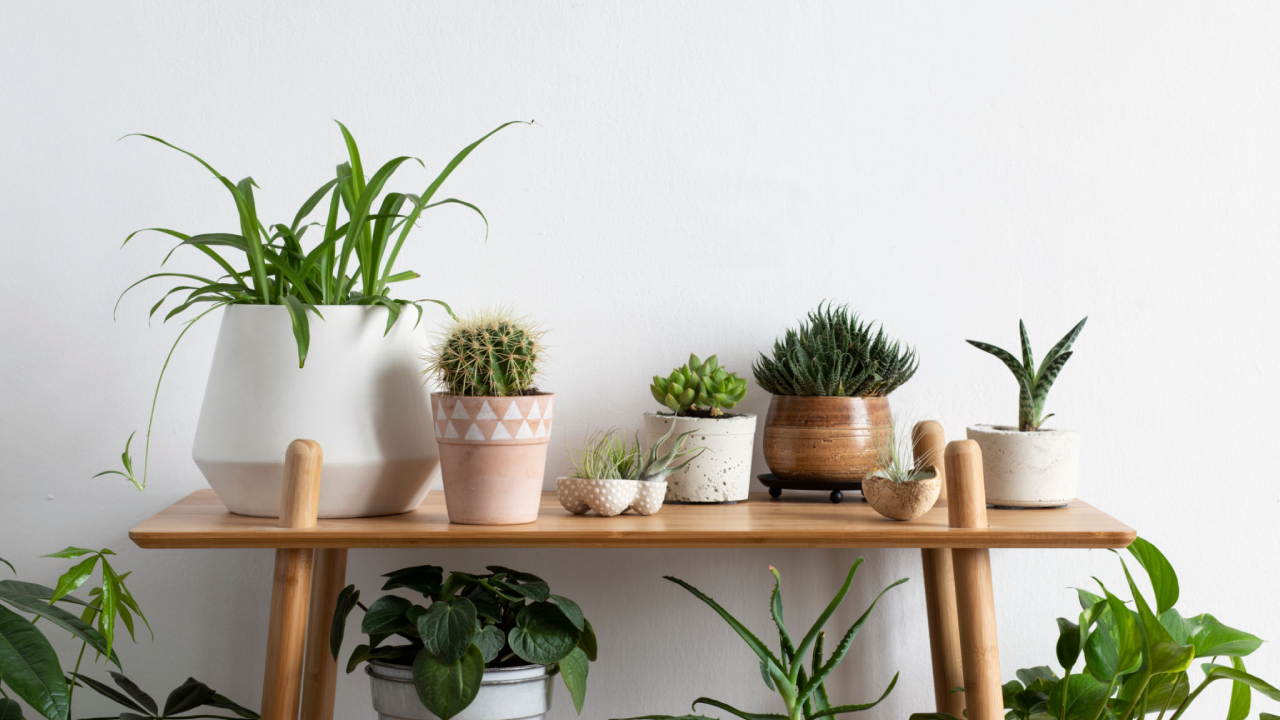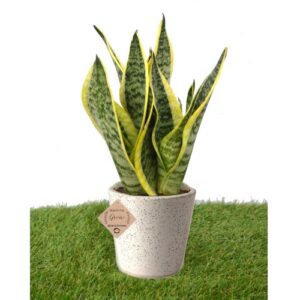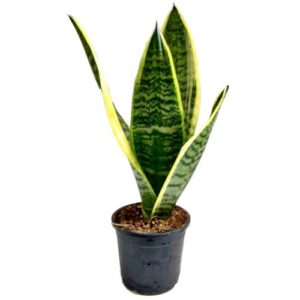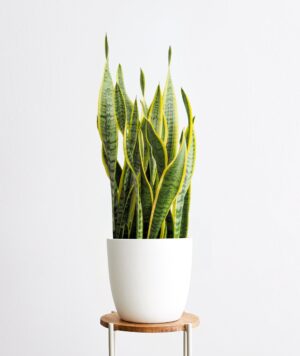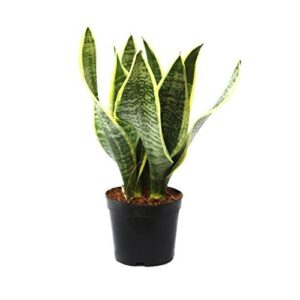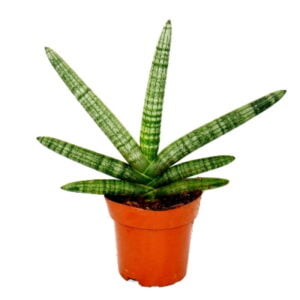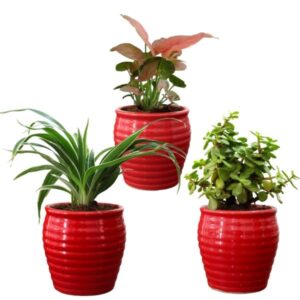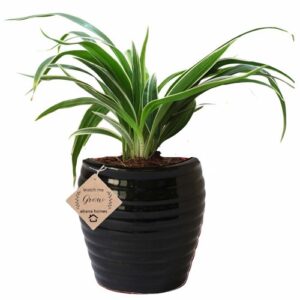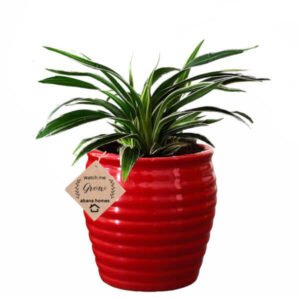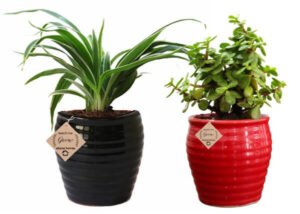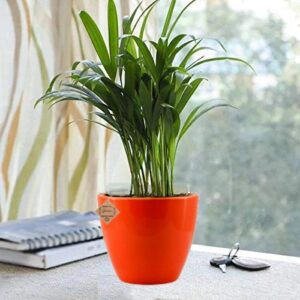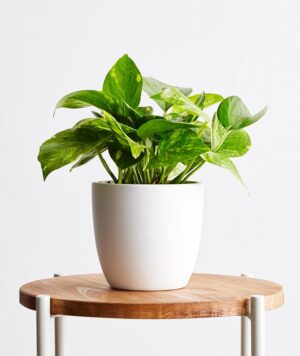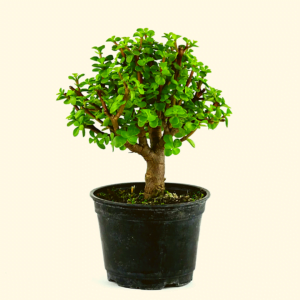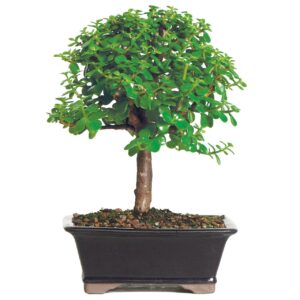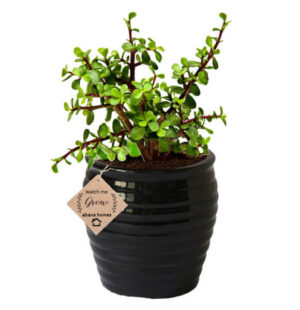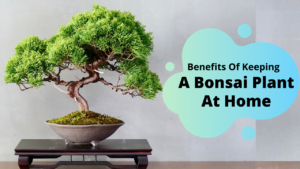Do you want to add greenery to your home? Wondering which best indoor plants will thrive in an Indian climate?
Plants are an integral part of Indian houses. Well, do you know that traditionally outdoor common indoor plants used to dominate the garden and window sills? However, nowadays, indoor plants bring some benefits as well! Also, by adding certain indoor plants to your home you can restore balance to your home’s energy.
So, to restore your home’s energy, I am going to share the list of more than 40 best low-maintenance indoor plants for the Indian climate. Easy to maintain, these indoor plants will brighten up your interiors and at the same time, purify all that stale air and toxic gases, leaving you as fresh as a dewy daisy every day!
So, Let’s get started!
Best Indoor Plants in India
1. Snake Plant
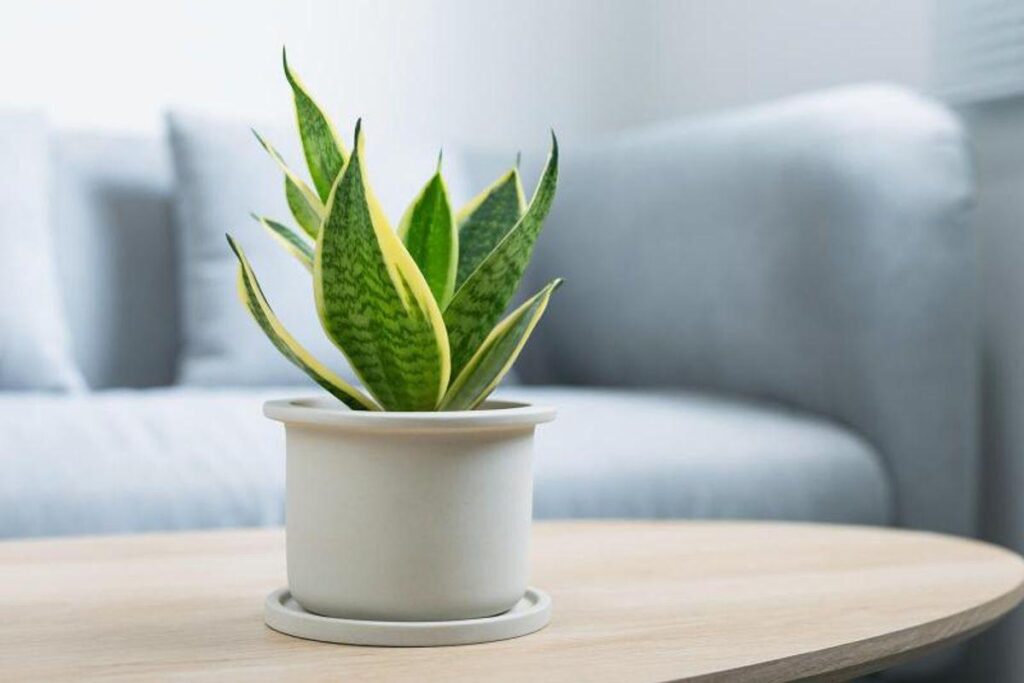
Botanical name: Dracaena trifasciata
Known as mother-in-law’s tongue, it is prized for its upright foliage with a variety of shades of green. Its yellow and cream stripes running down its margins will enhance your home’s beauty even more.
It is ideally suited for indoor air conditioning as it performs well under low light and absorbs different gases.
Snake Plant Care Instructions
Light: Blooms both under bright and low sunlight.
Soil: Can tolerate dry, poor soil conditions.
Water: Be careful not to overwater as the snake plant’s roots are susceptible to rotting. You only need to water it once a few months in winter.
Fertilizer: 10-15-10 Plant Food Fertilizer is ideal for snake plants, meaning 10% of the active components are nitrogen, 15% is phosphorus, and 10% for potassium. There should be other micronutrients too to help your snake plant’s growth in spring.
Snake Plants – Sansevieria are world’s best air purifying plants.
Note that Snake Plants are world’s greatest Air Purifying Plants for Home Indoor.
2. Spider plant
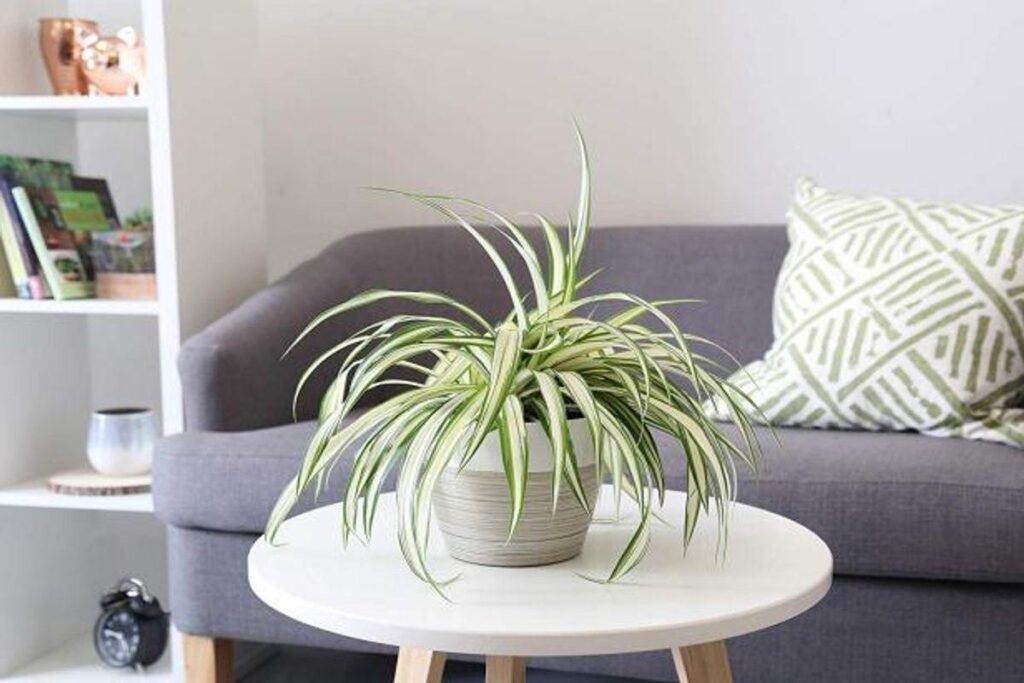
Botanical name: Chlorophytum comosum
A spider plant has long, thin leaves that are beautifully bordered by white and green stripes. You can see a dense cluster of them growing downwards. Furthermore, this indoor plant improves air quality by removing xylene and formaldehyde from the surrounding area.
Spider Plant Care Instructions
Light: You can grow this indoor plant anywhere except in direct sunlight. This plant even thrives under artificial lighting!
Soil: Any good potting mix will do.
Water: To water, this plant properly, only use tepid water throughout the summer months and make sure the soil is evenly moist. In winter, you can allow the soil to dry out between waterings.
Fertilizer: You can feed your spider plants with an all-purpose fertilizer once every month in their active season.
Get Spider Plants in Ceramic Pots for your home garden
3. Weeping fig

Botanical name: Ficus Benjamina
There are many slender branches that emerge from the gray trunk of the weeping fig. Although it can grow in limited light, it prefers bright indirect sunlight and constant soil moisture for optimal growth. It is ideal for cleaning the air in homes due to its ability to remove xylene from the air.
Ficus Benjamina Care Instructions
Since it grows too large, it needs to be pruned regularly and protected from drafts of wind as it is sensitive to cold weather. In addition, this indoor plant can cause allergies, so do some research before you purchase it.
Light: It thrives both in bright sunlight and in shade.
Soil: Any soil with good drainage will do.
Water: During the summer, water regularly, and sparingly during the winter.
Fertilizer: The ideal fertilizer for weeping fig will have an N-P-K balance of 3-1-2. But, an all-purpose fertilizer that has balanced nutrients can work well as well.
4. Areca Palm
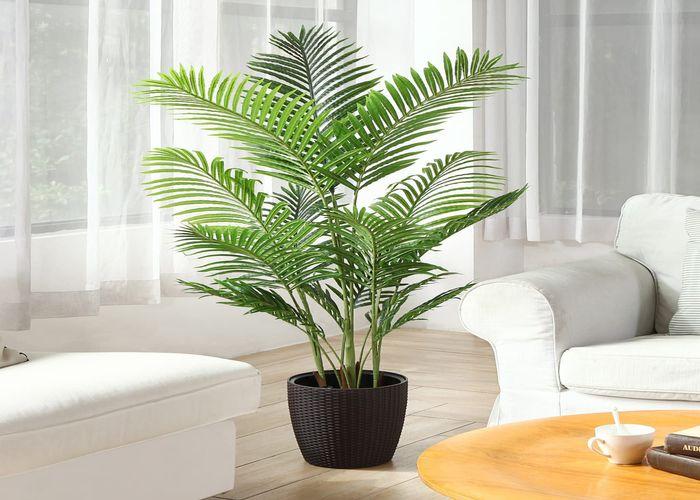
Botanical name: Dypsis lutescens
With its arching fronds, narrow leaves, and green leaflets, the Areca palm will brighten up every corner of your house. As its fronds arch, it is called a butterfly palm as it is similar to a butterfly’s wings.
In addition to its ability to absorb formaldehyde, toluene, and xylene from the surrounding environment, it also filters out VOCs (volatile organic compounds).
Areca Palm Care Instructions
There are a few basic things you need to do in order to take care of the Areca plant. Ensure that the plant is not underwatered or overwatered and that there are no bursts of dry air.
Light: Place the plant in partial shade or under a window as palms thrive in low-light conditions.
Soil: For best results, choose rich, acidic soil that drains well. To avoid the soil becoming too heavy or clay-like, mix it with a measure of the builder’s sand.
Water: Make sure the plant does not sit in water as root rot is easy to develop. Also, make sure that the water does not contain chemicals, or else the leaves will develop freckles.
Fertilizer: A perfect fertilizer for the Areca Palm will be with higher levels of nitrogen, potassium, and lower levels of phosphorus.
Get beautiful Areca Palms for Your Home
5. Boston Fern
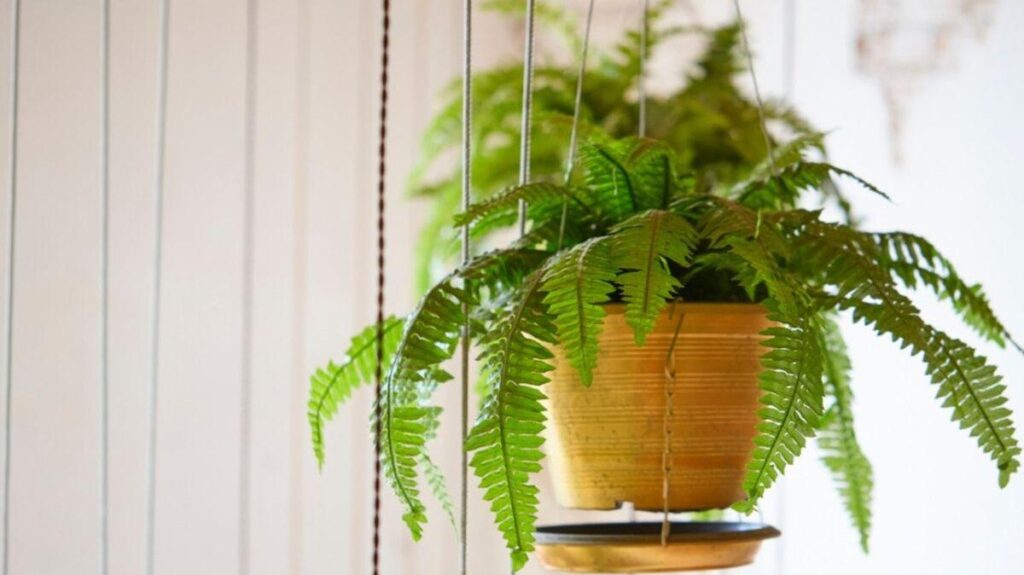
Botanical name: Nephrolepis exaltata
In India, when it comes to the best indoor plant for hanging baskets, then Boston ferns are always in the top spot. With its trailing habit, it cascades fronds with alternate, green leaves.
Boston ferns need bright indirect light for optimal growth, and as it removes toxic VOCs from the air, it is a blessing for houses.
Boston Fern Care Instructions
Light: It prefers sun to partial shade or light shade.
Soil: Do well in moist, well-draining soils that are humus-rich.
Water: In summer, the Boston Fern needs lots of water and frequent misting. Water the plant abundantly as often as necessary as long as the room temperature remains above 13°C (55°F).
Fertilizer: In the spring and summer, Boston ferns are required to be fed once a month. Ensure the fertilizer is water soluble.
6. Baby Rubber Plant
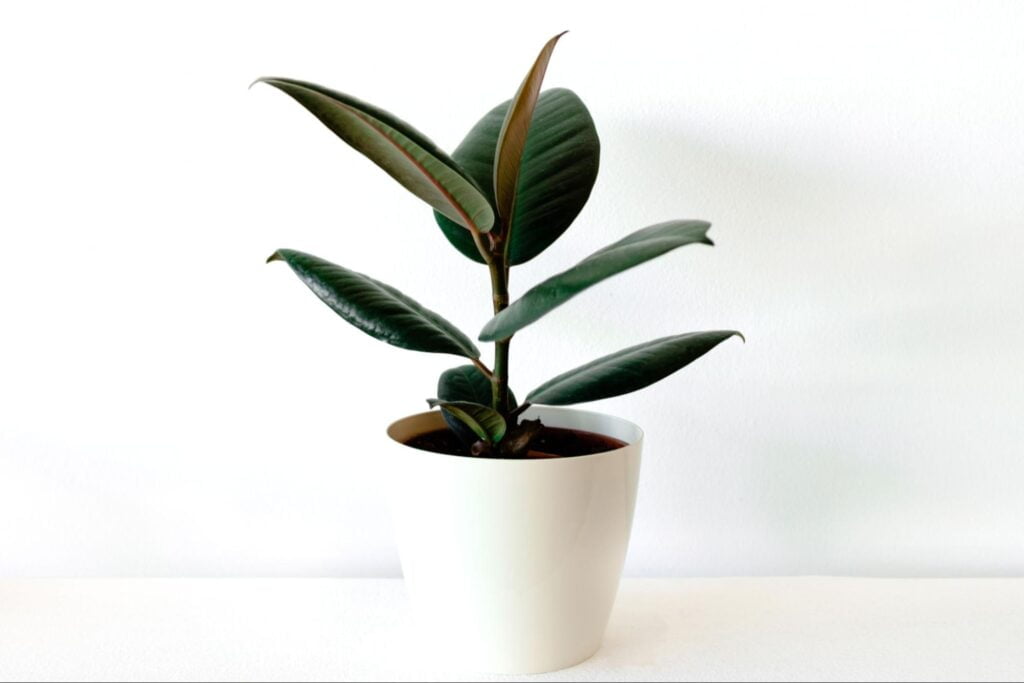
Botanical name: Peperomia obtusifolia
With its lance-shaped leaves and trailing growth habits, the Baby Rubber plant can make an excellent addition to hanging baskets. Depending on the variety, oval leaves can be green or striped. In addition, it blooms white flowers during the spring and fall.
Baby Rubber Plant Care Instructions
Light: Rubber plants like bright light, but not direct sunlight. If possible, place them in a place that is shielded from direct sunlight.
Soil: Nutrient-rich, well-draining soil is ideal for baby rubber plants. For drainage, you can add a good fistful of bark or perlite to general mixes.
Water: Their water requirements vary depending on the season. In the summer months, they need regular misting; as winter approaches or autumn approaches, they need less water every couple of weeks in order to prevent wilting.
Fertilizer: The ideal fertilizer for rubber plants is 24% nitrogen, 8% phosphorus, and 16% potassium.
Get Beautiful Areca Palms for Your Home
- Original price was: ₹1,300.00.₹899.00Current price is: ₹899.00.
7. Pothos
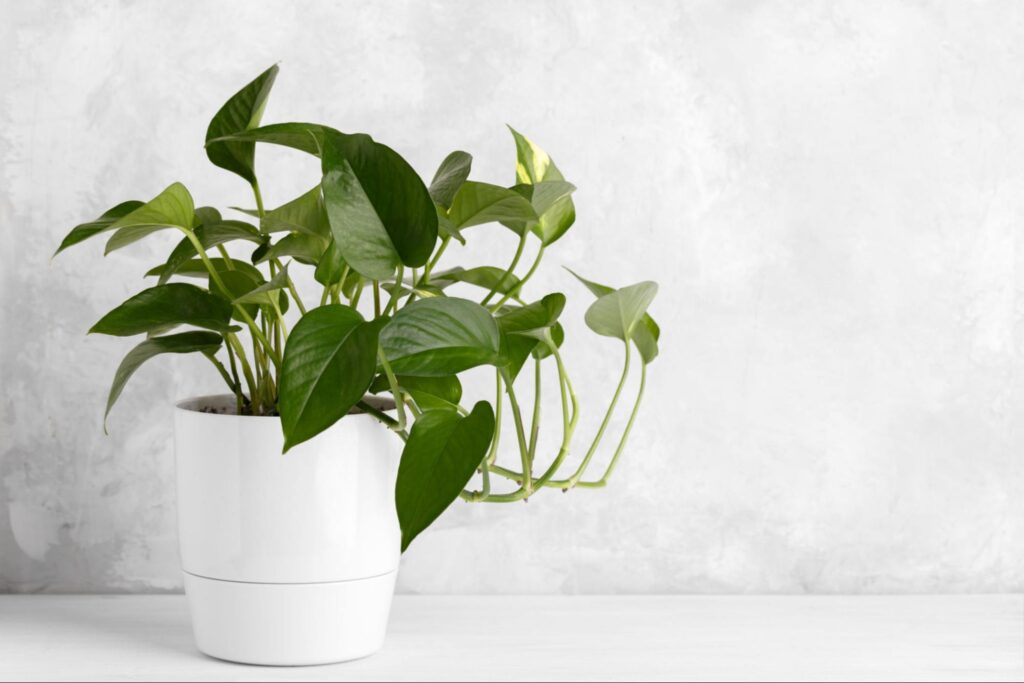
Botanical name: Epipremnum aureum
One of the ‘hard to kill’ houseplants, Pothos is traditionally believed to bring good fortune to its owner. Moreover, with its creeping nature, you can train it on trellises or hang it from the ceiling in hanging baskets as a vine. The heart-shaped leaves of this plant are tinged with creamy yellow. In addition to absorbing xylene, toluene, and benzene, this plant also filters the air naturally.
Pothos plant care instructions
Light: They are very easy to take care of and can thrive in low to moderate light conditions.
Soil: The pothos plants don’t like wet soil, they will rot. Use a general well-draining potting mix (or a soilless mix) to grow pothos.
Water: Overwatering may cause the roots to rot. They need moist soil, but not soggy.
Fertilizer: Provide pothos plants with a proportional normal houseplant fertilizer occasionally during the spring and summer months. Do not feed pothos in winter when the plant goes inactive.
Get Beautiful Golden Pothos for Your Home
8. Grape ivy
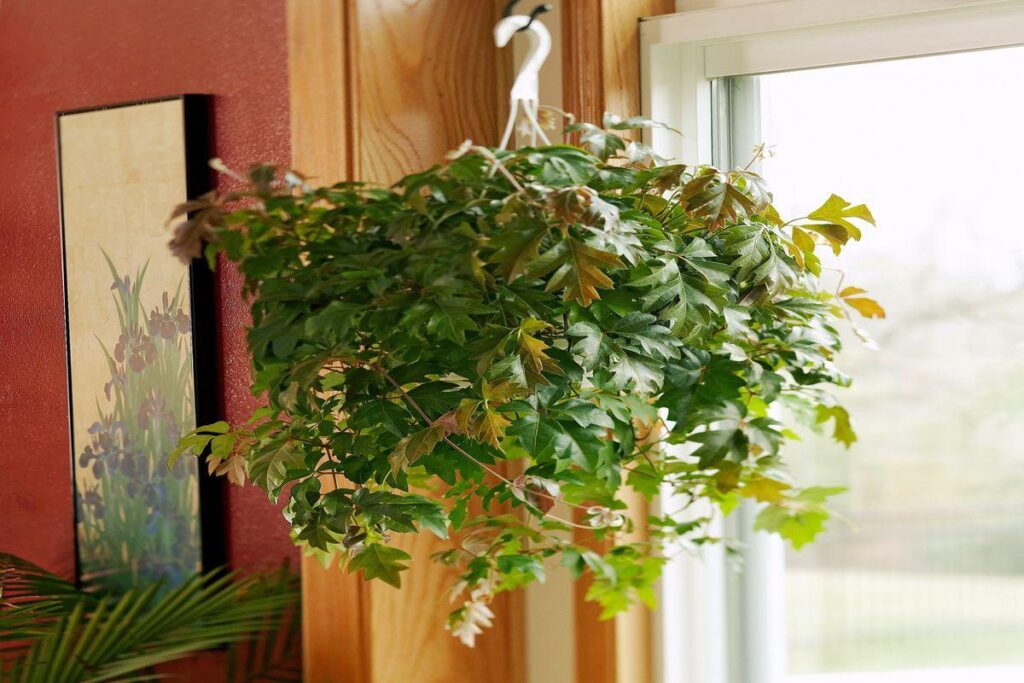
Botanical name: Cissus rhombifolia
Those with “black thumbs” will appreciate the forgiving and low-maintenance nature of the grape ivy plant. An important feature of grape ivy is its scalloped margins. With a trellis or other supports, this vine plant can be trained either horizontally or vertically. At room temperature, it thrives in moderate sunlight.
Grape Ivy Care Instructions
For the plant to remain vibrant and grow well, a moderate level of care is required.
Light: Grape ivy thrives in low-light conditions and thrives in temperatures of 68-82℉
Soil: A potting mix of peat, bark, perlite, water, styrofoam, and calcined clay would aid water retention and provide excellent drainage since the grape ivy roots need excellent aeration.
Water: The plant requires a medium amount of water since overwatering can cause its leaves to drop prematurely.
Fertilizer: Provide your grape ivy during the active season with a diluted fertilizer in liquid form, decreasing both water and fertilizer.
9. Croton
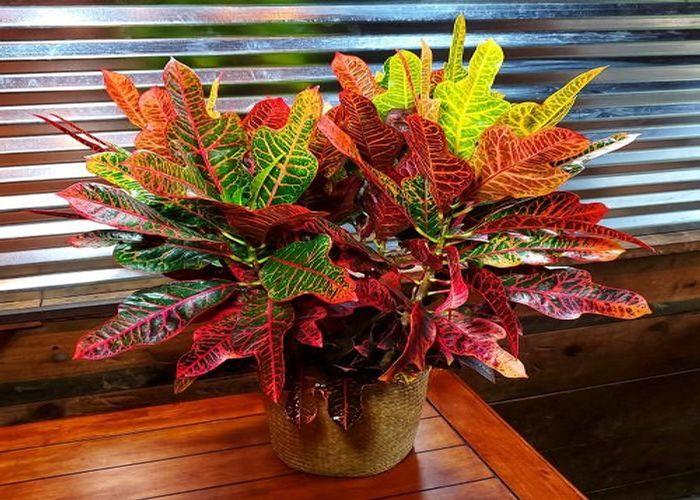
Botanical name: Codiaeum variegatum
Color your space with the Croton plant. This plant displays a variety of vibrant colors including red, green, yellow, and orange on its leaves, which add a tropical touch to homes. If you want to see its best color, place this plant near a sunny window or the brightest part of your home.
Croton Plant Care Instructions
Light: To develop those rich, deep tones, place Croton under an east or west-facing window with plenty of light.
Soil: Ensure the soil is well-draining and rich in organic matter to keep the plant healthy.
Water: Do not water the soil until it feels dry to the touch. Make sure not to overwater the plants, and keep a humidifier handy.
Fertilizer: Apply steady-release doses three times every year: before spring, midsummer, and before fall.
10. Lady’s slipper orchid

Botanical name: Cypripedioideae
It is slightly aromatic, resembling the slippers of the lady, and with a small opening at the front. Depending on the variety, blossoms may vary in color from red, pink, purple, or yellow. Orchids in this genus prefer dry areas accompanied by moist, well-aerated soil.
Lady’s Slipper Orchid Care Instructions
Light: Avoid exposure to both direct sunlight and direct sunlight.
Soil: A well-aerated soil is important.
Water: Only use distilled water or rainwater to prevent any chemicals from seeping through.
Fertilizer: This plant grows in inadequate desert soil that is lacking in all kinds of nutrients. Thus, fertilizer is not required. But indoor plants in pots have limited soil as well, so a regular fertilizer once a year won’t hurt.
11. Jade Plant
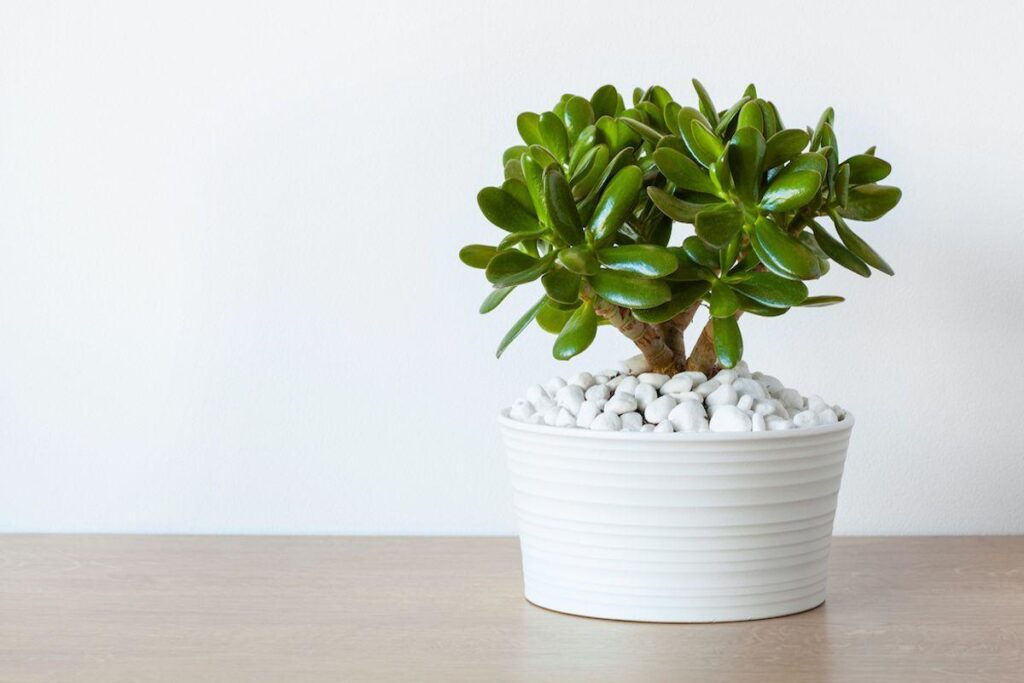
Botanical Name: Crassula ovata
On its woody stems, the Jade plant has plump, fleshy, oval-shaped, green leaves that resemble miniature trees. When exposed to sunlight, the leaves take on a reddish hue. Fortunately, the plant is fairly low-maintenance and has a long lifespan.
Jade Plant Care Instructions
Light: Jade needs plenty of light. Hence, placing them in the south or west-facing windows at least four hours per day is advisable.
Soil: Use fast-draining soil with sand grains for jade plants.
Water: Allow soil to dry out between waterings, and do not overwater them.
Fertilizer: Succulents are known for their carefree attitude, which is why many plant owners underfed their jade plants. But the lush growth you see on the internet can be achieved with little application of supplements. Use a balanced 20-20-20 fertilizer at one-quarter strength and fertilizer with low-level nitrogen on young jade plants.
12. ZZ Plant

Botanical Name: Zamioculcas
This plant is characterized by opposite, pinnately compound leaves arranged on its thin stems. The ZZ plant is drought-tolerant and non-demanding, making it ideal for busy gardeners. Additionally, it can thrive in low-light conditions, making it a great addition to dim corners.
ZZ Plant Care Instructions
Light: Low-light conditions are fine for the plants, but indirect light is preferred.
Soil: You can use most standard potting mixes for your plant. In order to improve drainage, mix in perlite or sand.
Water: When the soil is dry, water the plant.
Fertilizer: If you’re expecting to improve your ZZ plant’s size or vigor, feed your ZZ plant with indoor plant fertilizer.
Get Yourself a Desk Plant That Purifies Air Too and Grows in Low Light Situation.
13. String of Pearl

Botanical Name: Senecio rowleyanus
A string of pearls is characterized by wire-like stems covered with rounded and fleshy leaves that have the appearance of pearls. A String of pearls planted in a hanging pot or basket is a perfect addition. In addition, it is resilient, low maintenance, and easy to grow. The plant can tolerate some drought, as well as bright indirect sunlight.
Strings of Peal Care Instructions
Light: A string of pearl plant thrives when it receives both direct and indirect sunlight.
Soil: Your string of pearl plants will do well with any succulent potting soil, but sandy soil is ideal.
Water: When the plant is growing, keep the soil lightly moist in the spring and summer, and then reduce the water in the winter.
Fertilizer: Provide fertilizer to your plants biweekly during the growing season with a well-proportional fertilizer.
14. Peace lily
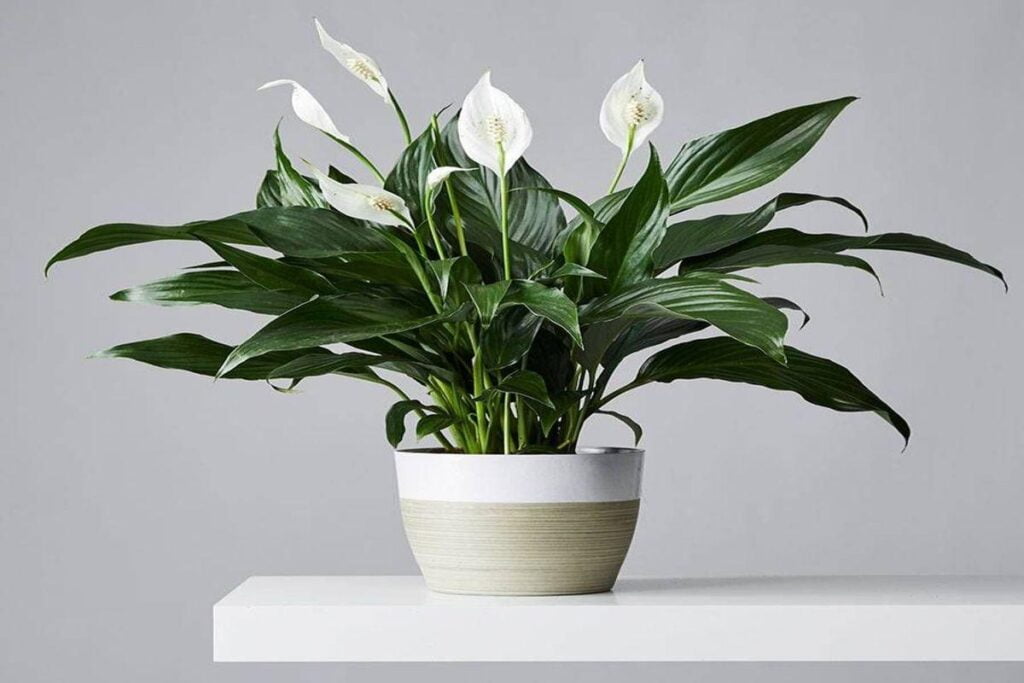
Botanical name: Spathiphyllum
A life filled with peace and contentment is what we all strive for. Indoor plants like the Peace Lilly have become universally associated with these aspirations. The elegant dark green leaves and the huge, fragrant flowers will calm your soul and your mind after a long day of work! In addition, the plant removes contaminants from your home such as benzene and formaldehyde, helping you overcome allergies.
Peace Lilly Plant Care Instructions
Light: It thrives in shade and requires little sunlight.
Soil: Keep moist, water if it becomes too dry.
Water: Needs only weekly watering.
Fertilizer: Peace lilies are heavy feeders and appreciate frequent doses of plant food. But, it’s not that hard to follow their feeding routine, Just apply a slow-release fertilizer and follow what the packet’s guidance is saying.
15. Aloe vera
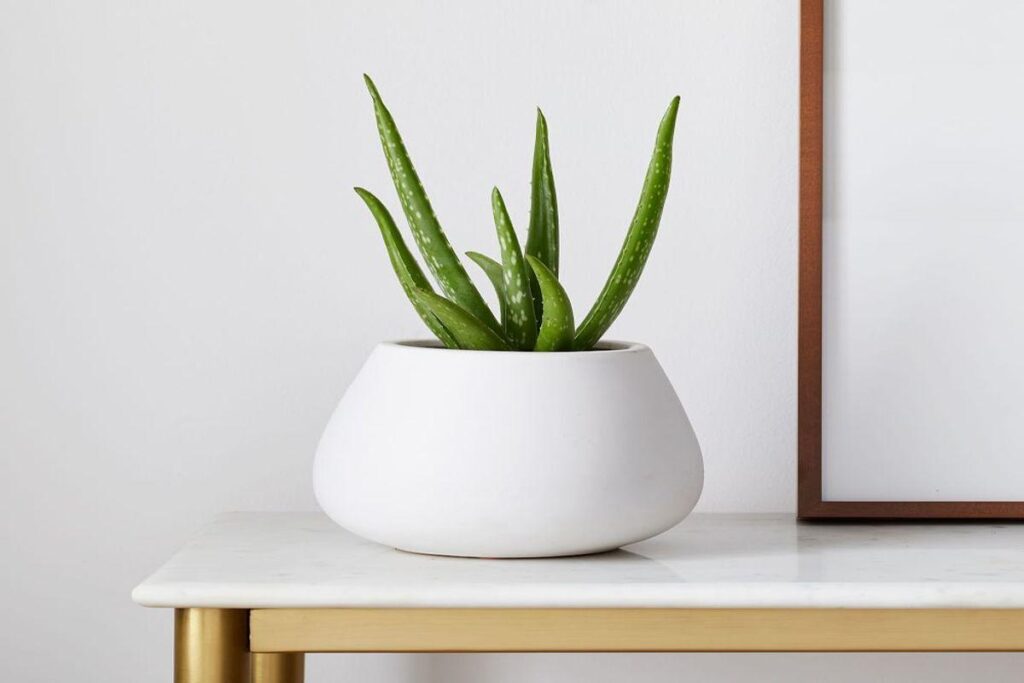
Botanical name: Aloe barbadensis miller
Aloe Vera is also known as the miracle plant. This is because it does many miraculous things. Worldwide, it’s known for its medicinal properties that rejuvenate, soothe, and heal the human body.
Unlike other succulent plants, aloe has stemless leaves with thick flesh and serrated edges. It grows best in Indian Climates and thrives best as an indoor potted plant. These plants are relatively resistant to insects. That means you don’t have to spend time swatting pests off of leaves, and you have an easy way to heal cuts, bruises, and skin problems!
Aloe Vera Plant Care Instructions
In order to prevent it from shriveling with too much water or burning under too much sunlight, it requires moderate care.
Light: To grow well, the plant needs bright, sunny conditions. Place it under windows facing south or west for best results.
Soil: A well-drained sandy potting soil is best for growing aloe vera indoors. To ensure excess water drains away easily, experts recommend purchasing cacti and succulent mix that are commercially available.
Terracotta pots are best for growing aloe vera indoor plants since they are porous, which helps the draining process.
Water: Since Aloe vera is a succulent plant, it needs dry conditions to thrive. Standing water is not good for Aloe vera plants. Be sure to dry your pot completely before re-watering.
Fertilizer: Feeding potted aloe once a year might benefit in keeping a vigorous growth. But they are equipped for poor soil conditions, even nutritionally, so additional feeding is not needed.
16. Lucky Bamboo Plant

Botanical name: Dracaena sanderiana
A name starting with “Lucky” itself is an obvious clue.
In India, it is seen everywhere – both in homes and at business places, since it is said to bring happiness and prosperity.
Feng Shui practitioners also recommend the Lucky Bamboo, which is called Fu Gwey Zhu in Chinese. The Fu symbolizes luck, the Gwey represents power, and the Zhu symbolizes bamboo.
In Feng Shui, a Lucky Bamboo’s positive effect differs according to the number of stalks it has tied together, with each stalk representing a different level of prosperity and gain.
Lucky Bamboo Care Instructions
A moderate level of care is required for Lucky Bamboo. It is critical to remember that Lucky bamboo plants require fresh water at all times. As the plant is susceptible to chemicals, any traces of chlorine or fluoride in the water will affect its leaves, turning them yellow or brown.
Light: Place it by the window so that it gets indirect sunlight to grow. It cannot grow under direct sunlight.
Soil: Rich, well-drained potting soil is best.
Water: If growing in water, change the water every two weeks. And for growing the lucky bamboo in soil, don’t forget to always keep the plant moist, but not soaked.
Fertilizer: Fertilizing lucky bamboo that grows in water is easy to follow. Give one drop of all-purpose liquid fertilizer in water and that’s it. Do it every time you change the water. Soil-grown plants can have the same method, but do it while watering the plant.
17. Ferns
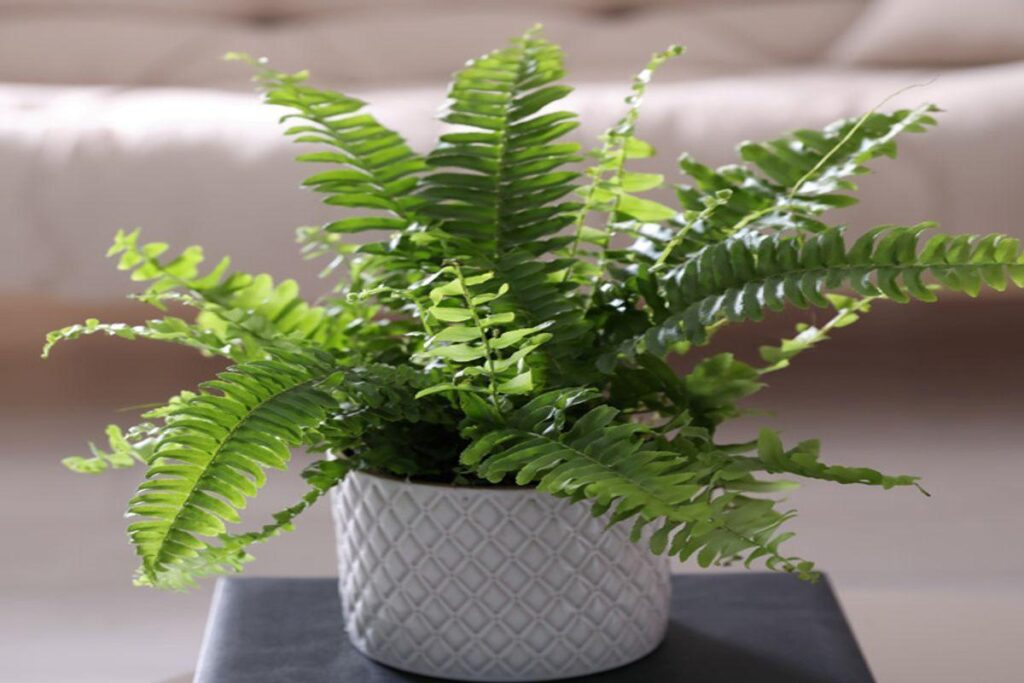
Botanical name: Tracheophyta
Here’s a plant that has been around since before you and your ancestors were born!
Among the oldest species of plants on earth, ferns date back millions of years. A fern is a vascular seed, that neither bears seeds nor flowers.
They add an ornamental touch to your house with a lush canopy of green leaves. Additionally, they remove chemical pollutants from the air and heavy metals, especially arsenic, from the soil.
Fern Care Instructions
It would be better to grow them in plastic containers instead of clay ones since they retain moisture better. Don’t let your Fern plant dry out by placing it near vents and fans. It is also a good idea to add well-loosened moss around the base of the plants to retain moisture.
Light: The plant thrives in low light conditions, so place it under a north or east-facing window.
Soil: Moist, well-drained soil is ideal. Choose a soil mix with high organic content, such as a good peat moss mix.
Water: Keep the fronds hydrated, but watch out for the warning signs. As too much watering turns the fronds yellow and too little watering causes the fronds to wilt.
Fertilizer: Ferns are not fond of fertilizers, but if you must use them, give them after weakening their strength. If the tips turn brown, do not fertilize. Brown frond tips are signs of over-fertilization.
18. Chinese evergreen

Botanical name: Aglaonema
Another plant that will bring you good fortune!
In India, Chinese evergreens are popular houseplants, and for good reason. Not only do these herbs bring prosperity into the house, but they are among the most durable indoor plant you can grow. These plants tolerate poor light, dry air, and drought well.
If you travel a lot, forget to water the plant, or live in a less-than-sunny place, still, the Chinese evergreen plant will continue to thrive!
Their leaves are lance-shaped and have varying shades of silver, gray, or green.
Chinese Evergreen Plant Care Instructions
Chinese evergreen plants only ask for protection from extreme cold and excessive sunlight, because they cannot tolerate either. Also, prune any flower cluster immediately to prolong the life of the plant.
Light: Low to medium light is fine.
Soil: Ensure it is evenly moist. Fertilize minimally as the Chinese evergreen plants become easily injured when overfed.
Water: You may choose moderate watering since Chinese Evergreens require evenly moist soil. After watering, let the soil dry out a bit between intervals.
Fertilizer: To get the healthiest growth feed your Chinese evergreen with steady-release pellets or twice a year, at the start and end of its growing season.
19. Anthurium

Botanical name: Anthurium
Do you want to add a bit of color to your home but aren’t just looking for green plants?
Then you should consider Anthuriums. There are clusters of leaves on this plant, and the inflorescence bears flowers of different colors. Also, on the spadix, there is a dense spiral of flowers.
Alternatively, you can choose a climbing Anthurium to cover a bare wall. In such a case, be sure to provide the plant with a sturdy totem pole so it can climb easily.
Anthurium Plant Care Instructions
Be sure to wipe off the leaves once in a while with water to keep them free of dust and insects. As well, plants with solid roots in pots will benefit from a weak fertilizer solution every two weeks.
Light: It thrives in temperatures between 60 – 70 °F and needs less sunlight than other indoor plants.
Soil: A moist soil high in organic matter is suitable.
Water: In hot and dry climates, make sure to mist and water the plant every day. However, if you live in an area with high humidity, you can easily skip watering for a week or two.
Fertilizer: It is secure and suggested to give liquid fertilizer throughout the active period. You can feed them weekly with high phosphorus fertilizer to encourage flower production but weaken the strength by blending it in water.
20. Money Plant
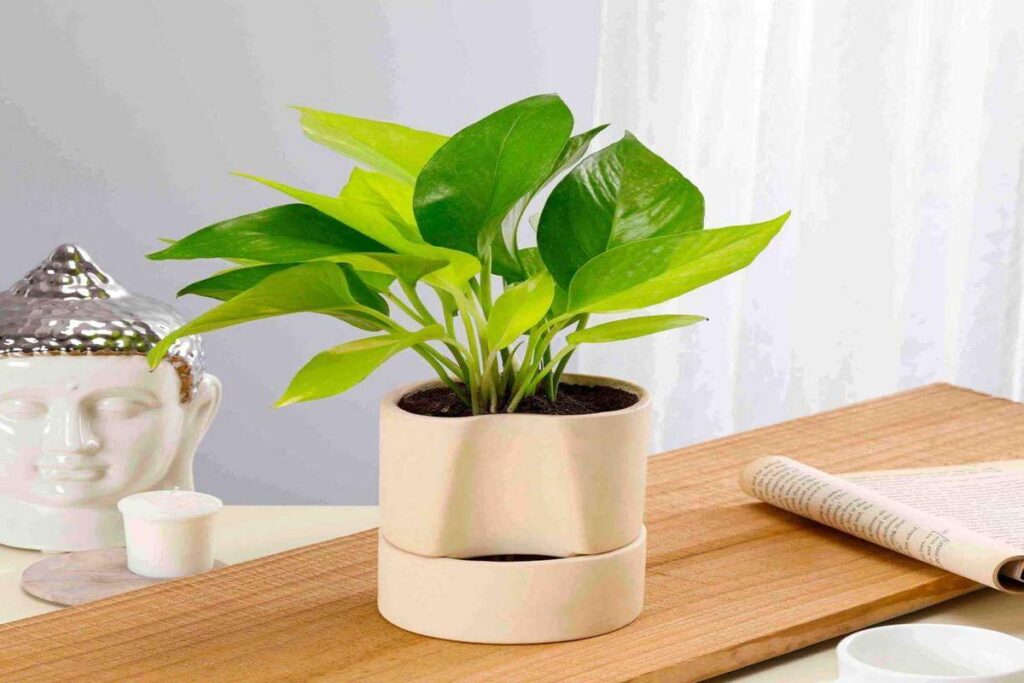
Botanical name: Epipremnum aureum
Wouldn’t it be great if leaves bore money as gifts?
Since they don’t, why not pick a plant with round, plump, flat leaves that resemble coins?
It doesn’t hurt the cause that the plant is attractive, easy to care for, and efficiently removes indoor pollutants such as formaldehyde and benzene.
Besides, as a common belief goes, while your house is full of plants, you will never be short of friends or money while it flourishes!
Money Plant Care Instructions
Keep the money plant away from drafts of wind to avoid leaf loss. A bright, steamy bathroom might be the perfect place for it as it thrives in humidity.
Light: Avoid direct sunlight since it can scorch the leaves. Instead, use low light.
Soil: In order to avoid root rot, choose soil that provides good drainage as well as sand and peat moss.
Water: You need to water this plant once a week, no matter what kind of environment you live in.
Fertilizer: Money plants aren’t serious feeders, so using the fertilizers only onetime a month would be excellent. The perfect fertilizer would be a steady-release compost.
21. Warneck Dracaena
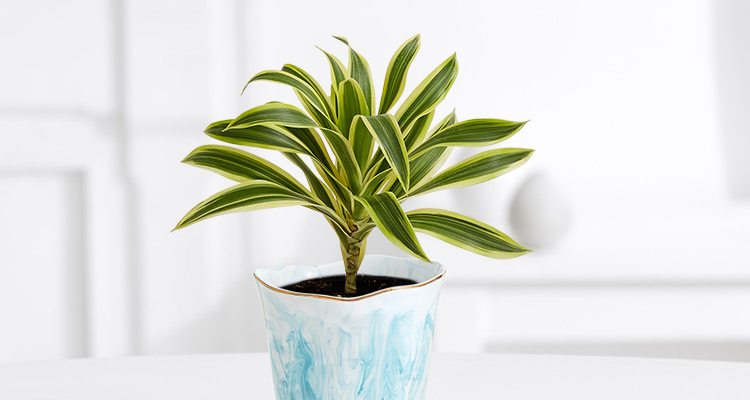
Botanical name: Dracaena deremensis
Another fuss-free houseplant to purify your home’s air from pollutants like xylene and toluene. It has a tremendous value attached to it because it can tolerate many different kinds of conditions well, including low light and bright light.
Dracaena Plant Care Instructions
The Dracaena plant requires very little maintenance. However, you would need to make sure that it is placed in an area that attracts little foot traffic since the foliage can be easily damaged.
Light: It grows best in bright, indirect light, but occasionally keeping it in the morning sun will keep it looking good.
Soil: If you use good potting soil, be sure not to add too much fertilizer, as excessive salts and fluoride in water can cause yellowing, leaf tips, and brown margins.
Water: When the soil feels slightly dry, water the rugged plant about once a week with tepid water. It is advisable to mist two or three times a week.
Fertilizer: You don’t need to fertilize these plants. But for best outcomes, stay till spring or the early weeks of summer to kick in as these two seasons are when this plant reaches at its peak growing cycles. Give a well-balanced fertilizer.
22. Heart-leaf Philodendron
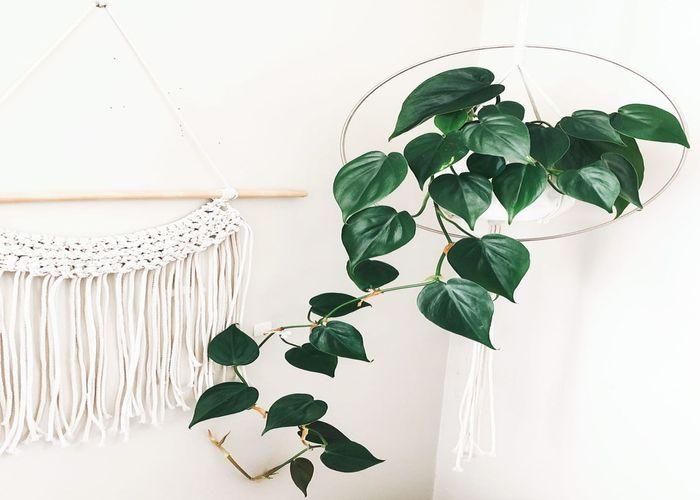
Botanical name: Philodendron hederaceum
As mentioned above, there are plants that can cover the walls or your home’s vacant spaces. However, what about adorning an empty table or desk?
How about making a love tree instead? (Love tree is the literal name of this plant in Greek). With its dark green, shiny heart-shaped leaves, it looks great on a tabletop or hung from a ceiling. Also, it thrives on neglect, is impossible to kill, and removes airborne toxins!
Philodendron Plant Care Instructions
Since the plant grows quite quickly, it would require a bit of care. It is also necessary to regularly prune the Philodendron plant so that it appears full rather than leggy.
Light: Place the plant under bright shade for optimum growth, but never under direct sunlight.
Soil: It is best to plant in moist soils with high organic matter. In the spring and summer, you could also add fertilizer sparingly.
Water: Make sure that the plant is moist, but not soggy. You can check whether you are watering correctly by looking at the leaves. Yellow leaves indicate excess water, and brown leaves indicate insufficient water.
Fertilizer: You can use a light fertilizer blend once or twice during the growing season, do not use it in winter.
23. Azalea
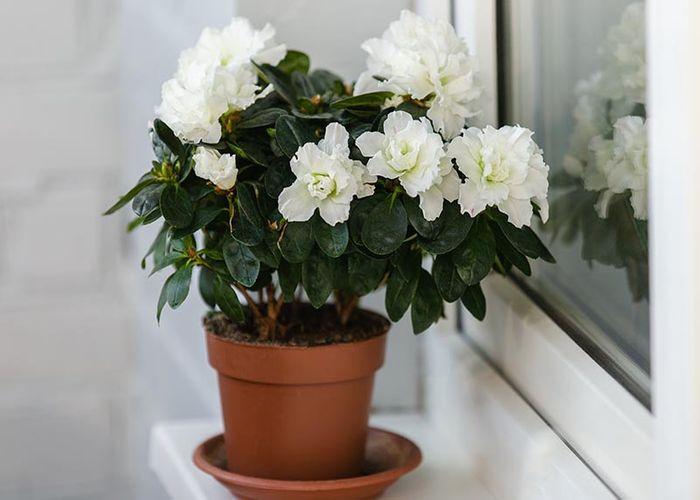
Botanical name: Rhododendron
Azalea is a popular and fragrant flowering shrub. It always signaled the upcoming arrival of spring. Moreover, the plant blooms in a multitude of colors. Additionally, they are well-known for their beauty and are immortalized in the poetry of Chinese poet, Du Fu of the Tang dynasty.
Plant these lovely blooms at your home and get the august companion!
Azalea Plant Care Instructions
Azalea requires minimal care and attention. However, you need to know that both the leaves and the flowers are toxic.
Light: For Azalea, the cooler the room, the longer will be the bloom! Ensure Azalea is not placed in direct sunlight, else its buds will fall off.
Soil: Plant this shrub in soil that is rich with peat moss. A clay pot for Azalea is highly suitable for good drainage.
Water: Submerged the azalea for a minute in water once or twice a week.
Fertilizer: Azaleas also do reasonably fine if provided with some fertilizer. Acidifying fertilizers are a suitable option where soils are neutral or alkaline. If you don’t understand what your soil contains, a basic well-proportioned fertilizer like 15-15-15 is ideal.
24. Gerbera Daisy

Botanical name: Gerbera
Introducing the fifth-best flower in the world to you! Gerber Daisy has showy and long-lasting blooms that signify innocence, purity, and cheerfulness. Also, it comes in a variety of colors, that will brighten up your every day.
In fact, Gerbera Daisies are sent out as gifts on several occasions to congratulate, express thankfulness, or greet others. These daisies are well-known to denote our feelings.
Gerbera Daisy Care Instructions
A moderate level of care is needed for Gerbera. However, if you provide favorable conditions to them, they will easily live for a couple of years.
Light: Gerbera Daisy needs an unusual combination of bright light and moderate temperature. Hence, it would be ideal to place them in the morning sunlight and keep them back inside in the afternoons.
Soil: You can use average to rich soils but ensure it has good drainage, otherwise your plant will quickly dry out.
Water: In summer, water it when the topsoil is dry to touch, and in winter, water sparingly.
Fertilizer: Monthly feeding with a water-soluble fertilizer is suggested to make sure the flowers bloom all summer. You can also use compost monthly instead of fertilizer.
25. Indian Basil

Botanical name: Ocimum tenuiflorum
In India, it has been cultivated for more than 5,000 years. Therefore, it is not surprising that Indians have always been deeply attached to the Basil plant. In fact, Ayurvedic medicine reveres it for its medicinal properties in the treatment of many diseases. Its dried leaves can also be used as mosquito repellents.
Meanwhile, Italian & Southeast Asian cuisines extensively use basil as a culinary herb to flavor dishes!
Indian Basil (Tulsi Plant) Care Instructions
To help your plant grow bushier, pinch the tops of the plant and snip off the flower buds. Make sure to remove any old or wilted leaves.
Light: As the plant thrives in sunlight, place it under the sun for at least four hours per day.
Soil: It is important that a plant be grown in fertile soil.
Water: If the topsoil feels dry, water the Basil plant. Do not water during the monsoons and water sparingly in winter.
Fertilizer: Feeding this plant with the supplement is not advised. The best way to deliver nutrients to this plant is to use good-quality soil and enrich that soil with some compost or manure.
26. Lavender
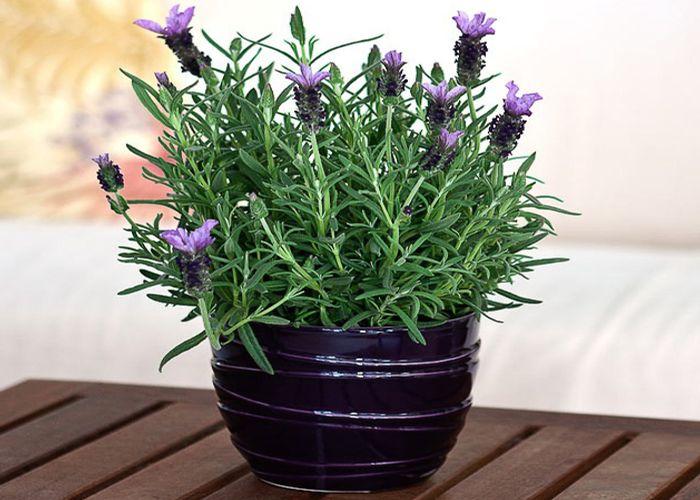
Botanical name: Lavandula
Providing color, fragrance, insect repellency, and beauty regimen all in one flower; that’s lavender, my friend!
Even though it does not fall under the traditional houseplant category, it is still beneficial, especially as it thrives in sunny climes like India!
Lavender Plant Care Instructions
Make sure it’s on a ledge or windowsill so it can grow as close as possible to the sun. In addition, your plant’s pot should only be a few inches larger than the root ball itself to prevent root rot.
Light: Lavender plant thrives in bright sunlight.
Soil: For the Lavender plant, put an inch or two of limestone gravel in the bottom of the pot, followed by a basic soilless mix. Add one tablespoon of lime to the soil to give it that alkaline edge.
Water: When growing lavender in a terracotta pot, water sparingly and pull back during the winter months.
Fertilizer: It’s a fine idea to put a handful of compost into the soil when you are first planting your lavender plants.
27. Donkey tail

Botanical name: Sedum morganianum
One of the most beautiful succulent plants is Sedum morganianum, which adds an exotic touch to any space where it is grown. Most often known as donkey tail, the succulent has bulged, pointed leaves arranged sequentially on a thin trailing stem.
With just a little care, indoor donkey tail succulents can create a desert feel in your landscape. It takes quite a while for the burrow’s tail (Donkey tail) to grow on this succulent, so patience is required.
Donkey tail Care Instructions
The plant is very sturdy and can overcome most adverse conditions if it is properly cared for. However, little maintenance is required for it.
Light: Provide partial shade for the plant.
Soil: Well-drained soil is enough.
Water: Less watering is required.
Fertilizer: Concentrate on providing your plant at the start of its growing season, using a slow-release, 20-20-20 fertilizer, which has similar parts nitrogen, phosphorus, and potassium. They don’t require it but will benefit from it. It’s better if you provide fertilizer with less amount of nitrogen in young trees.
In a hanging basket, the Donkey tail plant adds gorgeous texture to a room, and their protruding stems make the basket look splendid.
28. Fiddle leaf fig plant
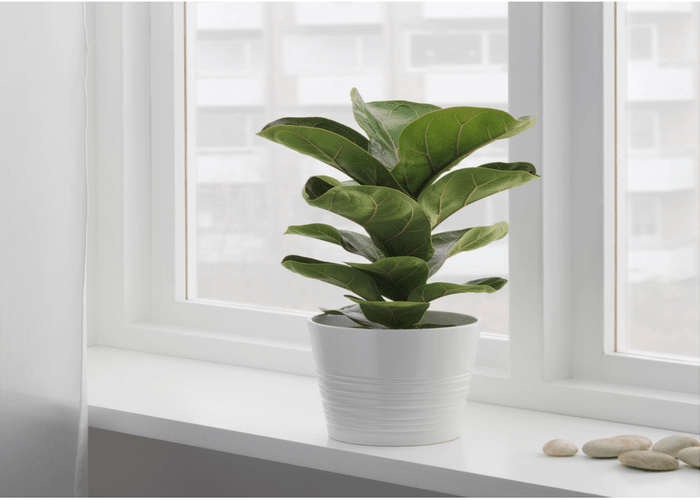
Botanical name: Ficus lyrata
Want a tree with large, glossy leaves arranged on a thin trunk? well, you have found it.
Due to their elegance and beauty, Fiddle leaf fig plants are in great demand these days. If you have a dull corner or space in your house, the plant can add style and drama. Despite its classy appearance, this plant requires very little care and can thrive with just partial indirect light from the window.
With its dark green leaves and glossy, violin-shaped trunk, it is the top favorite of all interior designers. This plant absorbs all toxic chemicals present in the indoor air, which promotes better sleeping by providing natural fresh air.
Fiddle leaf fig plant care instructions
Light: They thrive with just a little indirect light from the window.
Soil: Fiddle leaf fig trees grow best in well-draining soil. The best soil mix for Fiddle Leaf Figs consists of 1 part peat moss/coco coir, 1 part perlite, and 2 parts organic soil.
Water: Each Fiddle Leaf Fig requires a unique amount of water each week depending on its environment. A simple rule that is often followed by owners is to give a cup per foot. In other words, if your plant is two feet tall from the soil base to the tallest leaf, you should water it once a week.
Fertilizer: Feed them in the growing season with a high-nitrogen plant fertilizer, and follow the application instructions on the package.
29. Bunny ear cactus
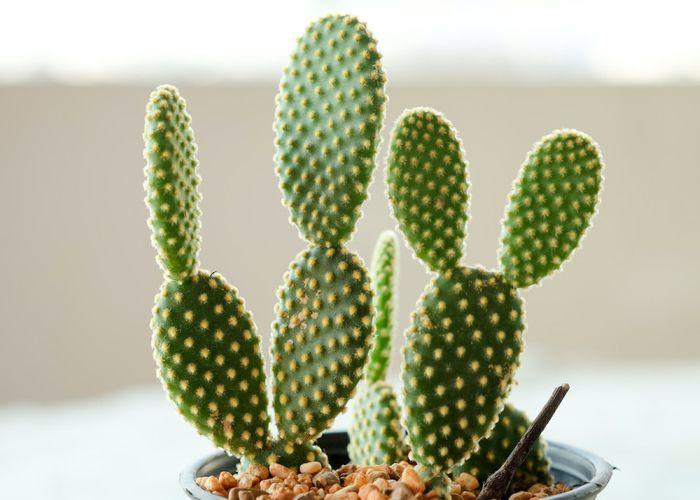
Botanical name: Opuntia microdasys
This adorable, but prickly plant is great for indoor use. Since their thorns are small and not so welcoming, it is best to keep the plant away from your children. A Bunny Ear Cactus makes the best indoor plant for dry areas because of its desert-like appearance. Also, the plant requires little care and does not need to be watered often.
These species are native to Mexico but have spread to different parts of the globe. Due to their yellow glochids on their green surfaces, they are also called Polka Dot cactus.
Due to their easy maintenance, they make the best indoor plant.
Bunny Ear Cactus Care Instructions
Light: It requires full sunlight, except during the winter months. Consider, placing them near your window or door to enjoy their beauty.
Soil: Sandy, well-draining soil is ideal for Bunny Ears cacti.
Water: For its first few months as a potted plant, it needs to be watered very frequently in order to establish its root system. After the roots are established, you can water the plant occasionally during summer and less during winter.
Fertilizer: This cactus thrives well in poor-quality soils and does not demand any kind of fertilization. But you can feed them once a year to boost their growth habit, not more than that.
30. Dragon tree
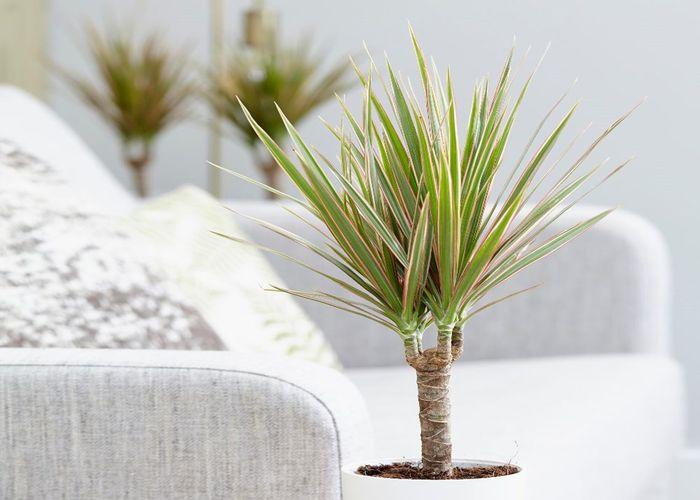
Botanical name: Dracaena Draco
The Dragon Tree houseplant is an excellent choice for indoor plants due to its robust root system and ability to survive in almost any climate. These plants are extremely easy to grow indoors and have beautiful foliage that looks absolutely stunning.
The plants can grow up to 6 feet long and serve as natural purifiers. Since it is toxic, it is best to keep it away from pets and children.
Dragon plant Care Instructions
Light: Moderate to low levels of sunlight are ideal for them. Additionally, it is best not to keep them in direct sunlight as their leaves tend to dry very quickly.
Soil: A loose, well-draining potting mix, enriched with peat moss, is ideal for growing dragon plants in pots.
Water: As an indoor plant, the Dragon tree requires very little water. Also, it is better to moisten the topsoil than to top it off with water.
Fertilizer: To encourage their growth, you can provide them fertilizer lightly at the start of the spring with a balanced steady-release liquid fertilizer. Actually, they are not heavy feeder and can thrive without any fertilizer.
31. Prayer plant
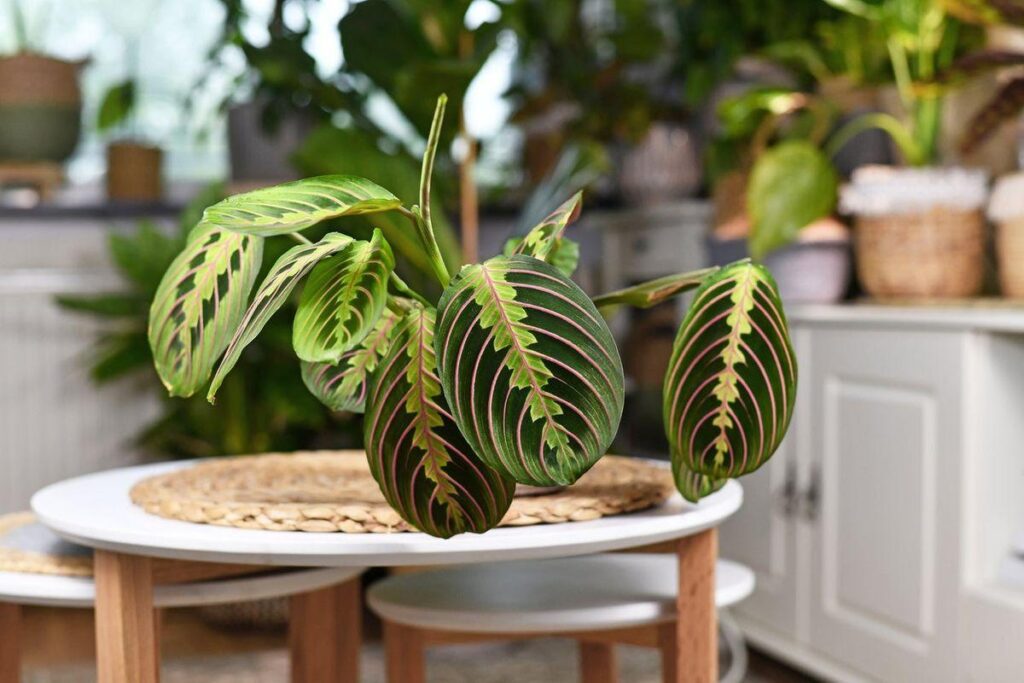
Botanical name: Maranta leuconeura
The prayer plant is an amazing addition to your collection of indoor houseplants. Rather than being dark green, their leaves are light green/white with red stripes down their spines. This plant receives its name from its unusual leaves. At night, they fold in an upright position like you would fold your hands in prayer.
Also, you get many varieties in Prayer Plants, namely between 40 and 50 different types. Although they differ in many ways, each has spines visible at its center that is quite similar.
However, their care is a little more complicated than that of Pothos or Snake plants.
Prayer Plant Care Instructions
Light: They don’t do well with direct sunlight, so it’s better to give them filtered indirect sunlight. Low light conditions are fine for them.
Soil: As long as the soil is well-draining, prayer plants can thrive in a variety of conditions.
Water: It is not a good idea to keep these gorgeous beauties dry. Water the plant every once a week in the summer. However, reduce watering in the winter. Be careful not to overwater the roots.
Fertilizer: Prayer plants can take fertilizer well, but if you notice burn-like spots on their leaves while staying indoors, it’s an indication that they are getting food more than they need. Generally, you can give normal houseplant fertilizer twice a month in spring.
32. Dwarf umbrella plant
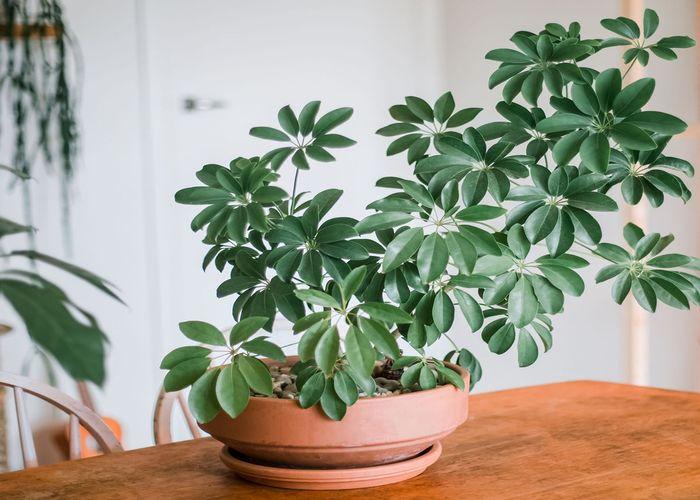
Botanical name: Schefflera arboricola
Dwarf umbrella trees are commonly known as Hawaiian umbrella trees. Both Southeast Asia and Australia are home to these trees, but they are widely grown in India. Because of its thin trunks and shrub-like looks, it is easy to grow and maintain indoors.
Moreover, there are many ways to learn how to grow Dwarf umbrella bonsais, and by using tutorials, you will definitely master the process of bonsai.
In addition, the Dwarf umbrella plants have low light requirements, and tolerance to low humidity, making them the best indoor plants. Since calcium oxalate is present, it is best to keep it out of reach of children and pets. It can cause digestive problems if consumed in large quantities.
Hawaiian umbrella tree bonsai Care Instructions
Light: The plants need low to moderate light and are therefore an excellent addition to indoor collections.
Soil: A good drainage system is needed for dwarf umbrella plants to prevent root rot due to excess moisture in the soil. If possible, use a peat-moss-based potting mix and plant the umbrella bonsai in a pot with proper drainage holes.
Water: All the time, they prefer moist soil. During the winter months, it is important to take caution not to let the soil completely dry out.
Fertilizer: Provide umbrella plants twice a week during the growing season with all-purpose fertilizer available for houseplants, or give two dosages of slow-release pellets. They are serious feeders and will profit from the added nutrients.
33. Grafted Ficus Bonsai
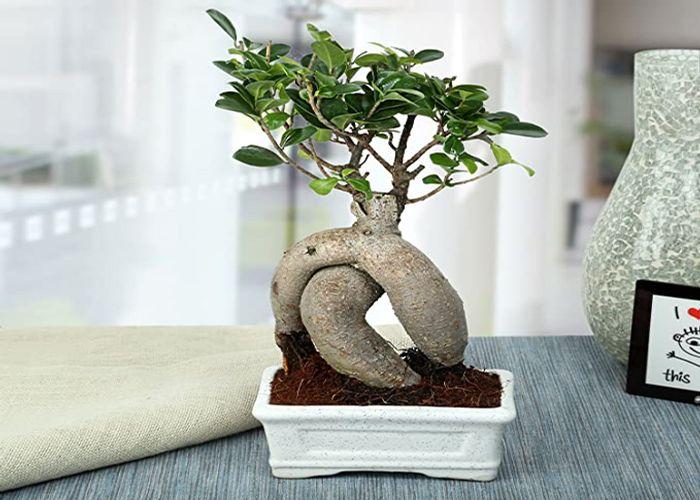
Botanical name: Ficus microcarpa
The Ficus is one of the most popular tropical and evergreen trees. There are more than 600 varieties worldwide. Since Ficus are mainly fast-growing plants, they make excellent choices for novice gardeners.
One of the popular species of Ficus, ginseng Ficus plants, has fat trunks and lots of exposed roots that give the tree a lush, tropical appearance. With their stocky structure, they will make an extremely appealing addition to your collection of Bonsais.
Grafted Ficus Bonsai Care Instructions
Light: High light environments are best for these plants, but low light can do fairly well. As with bonsai, Ficus also loves to get its share of sunlight to remain healthy and strong.
Soil: An ideal soil mix for Ginseng Ficus trees is 60 percent aggregate and 40 percent organic matter. If you don’t want to make your own, you can buy a pre-mix or make your own with pine bark, lava rock, and a product called Akadama, which holds water and slowly decomposes over time.
Water: Grafted Ficus need moderate watering, as excessive water can cause root rot. The best place to grow these plants is in shallow trays that contain small stones. The natural evaporation of water provides a natural habitat for bonsais.
Fertilizer: Bonsai grow on very little soil, so it is essential to fill their nutrient needs from time to time. Any multi-purpose liquid fertilizer will do the work, lessen the strength of the fertilizer by mixing 50% with water before using it monthly.
34. Asparagus Fern

Botanical name: Asparagus setaceus
These beautiful plants are a joy to have indoors. Asparagus Fern’s grass-like structure and soft hanging spurs make it an easy houseplant to grow. This plant grows rapidly, however, so one needs to be vigilant about the overgrowth.
Even though their spurs resemble soft bushy fur, they are quite prickly, so it is best to cover your hands when handling them. As a curtain rod cover, it can be displayed on your window like a creeper set.
Also, the asparagus fern bears stunning white flowers and small red berries. It is best to keep this plant out of children’s reach.
Asparagus fern Care instructions
Light: They prefer indirect or filtered sunlight. If they are exposed to direct sunlight, they will wilt or wither.
Soil: Ensure that asparagus ferns are planted in loose, well-drained potting soil that is moist and loose.
Water: Ferns require moist soil at all times. Make sure you do not overwater them as they will rot. During the winter, you need to water them every several weeks.
Fertilizer: During summer, potted plants might require weekly feedings; otherwise, feed monthly with all-purpose plant food in diluted form.
35. Lemon Button Fern

Botanical name: Nephrolepis cordifolia
These ferns are named after their rounded leaves, as well as their short and demure nature. Moreover, it is one of the easiest indoor plants to grow and one of the most widely available.
The cute and dainty look of these ferns makes them a perfect indoor plant. You can also plant them in terrariums to make your home look bright and full. Taking proper care of them ensures that they remain evergreen and act as natural purifiers. Also, when crushed, their leaves emit a light lemon scent.
They are perfect for your front door, windows, and even your living room.
Lemon Button Fern Care Instruction
Light: They do not need direct sunlight. Filtered or indirect sunlight will be fine.
Soil: Acidic, loamy, moist soil is ideal for lemon button ferns.
Water: Make sure the lemon button fern does not become overwatered or soggy. They need moist soil, primarily the top layer, that is well-drained. If the roots become soggy, they will wither.
Fertilizer: Ferns are typically light feeders and the lemon button fern is no different. Apply half-strength fertilizer every few months to give some extra boost.
36. Paddle Plant

Botanical name: Kalanchoe
Unlike other indoor plants, paddle plants feature leaves in the shape of paddles. Their short structure allows them to be potted easily in small pots. With red-tinged leaves, it has an excellent appearance and adorns the home beautifully.
Also, these plants have various names, but the most common are Flapjack Plants and Desert Cabbage. It belongs to the Crassulaceae plant family and makes an excellent indoor plant.
When it comes to greens, they are definitely worth investing in!
Paddle Plant Care Instruction
Light: Sunlight is best for them; however, you should avoid exposing them to too much heat. They do best during bright summer months.
Soil: Paddle plants prefer a rich, well-draining, mildly acidic, or mildly alkaline soil mix.
Water: It is best to not overwater paddle plants as they have similar watering needs to cacti. Also, make sure you have a drainage system at the bottom for excess water to drain. In addition, ensure the soil stays moist, but not soggy.
Fertilizer: Feed paddle plants with a balanced liquid houseplant fertilizer weakened to half strength once every month beginning in late winter or before spring.
37. Dieffenbachia

Botanical name: Dieffenbachia seguine
The Dieffenbachia plant is a simple green-leafed plant that is easy to grow indoors and maintain. This plant is a member of the Araceae family of tropical flowering plants. Many Indian households use these plants to decorate their living rooms or patios because of their aesthetic appeal.
Probably one of the easiest indoor plants to grow is the Dieffenbachia, which is a good way to start gardening indoors. It is important to take great care when planting a Dieffenbachia indoors. As their leaves are poisonous, one bite can paralyze a person. It is best to keep pets and children away from them.
Dieffenbachia or Dumb Cane Care Instructions
Light: It is best to place these plants in an area with minimal lighting. Filtered indirect light works best for them. As bright sunlight will quickly damage their leaves.
Soil: A well-drained soil is best for the dieffenbachia, so add some sand or perlite to the mixture.
Water: Due to their tropical nature, these plants require plenty of water. They thrive best in humid conditions. During summer, make sure you water them thoroughly, but not so much that you kill their roots. Water them less during winter.
Fertilizer: For best results, feed dieffenbachia regularly once a month with a proportional, weakened fertilizer, such as a 20-20-20.
38. Peperomia
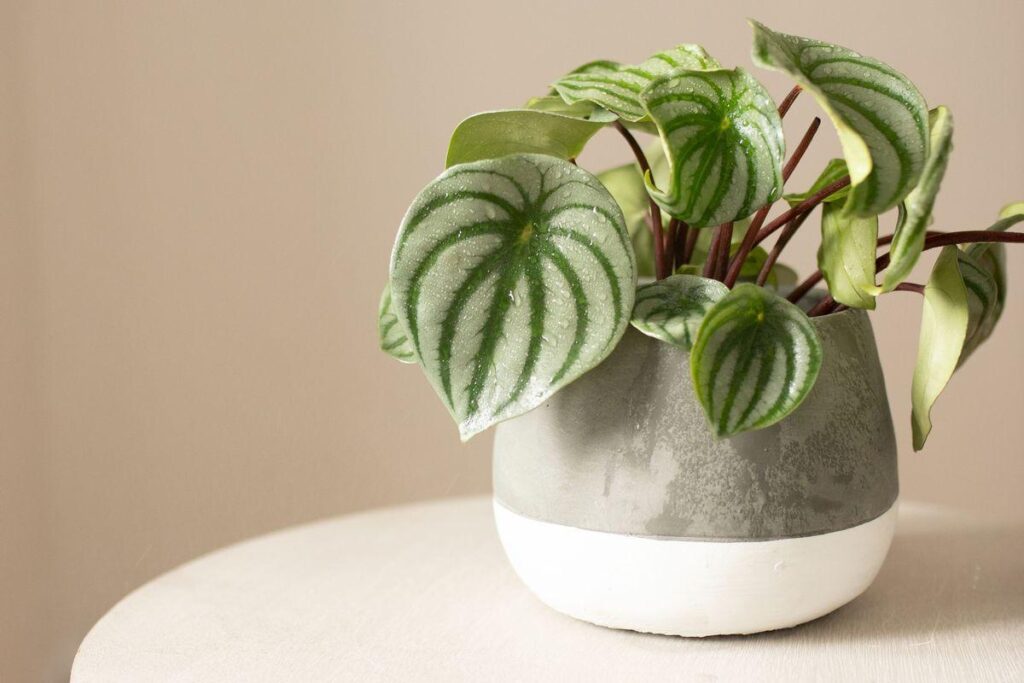
Botanical name: Peperomia
The Peperomia is a stunning indoor plant that will add an air of sophistication to your living area. These indoor plants do not require much maintenance. Moreover, their green stems and brown leaves have an appealing texture.
The “Pepper Family” consists of over 1000 different species of peperomias. Nevertheless, some of the most commonly grown peperomias are watermelon peperomia, heart peperomia with heart-shaped leaves, peperomia obtusifolia, minima, etc. These varieties are readily available and can easily be grown.
Also, hanging them in baskets makes them look absolutely stunning as their leaves trail down, giving them an extremely succulent appearance. As these plants are poisonous, they must be kept away from pets and children.
Peperomia Care Instructions
Light: Peperomia plants prefer indirect and filtered sunlight and should be kept away from direct sunlight. Keep in mind, that direct sunlight is too hot for their leaves to survive.
Soil: For peperomia, it’s a good idea to mix perlite, sand, or even gravel into the soil to prevent the roots from becoming too compacted.
Water: As indoor plants, they also don’t require much water, making them ideal for lazy gardeners. They need only a little water.
Fertilizer: Peperomias are slow-growing epiphytes, they can thrive their entire life without a single hint of supplement in their soil. But for that, their soil medium has to be proper, or else, you have to fertilize it with liquid fertilizer to give a boost of growth.
39. Calathea

Botanical name: Calathea
Indoor plants like Calathea are suitable for both office spaces and households. The plant’s bold green and white print on its leaves have earned it several nicknames, including cathedral plant, peacock plant, zebra plant, and rattlesnake plant.
Plants like Calatheas do not require a lot of space to grow, and they are easy to maintain. Their tropical Marantaceae family is among the most popular of all herb plants. Additionally, they have bright green leaves that are quite pleasing to the eye.
Calathea indoors Care Instructions
Light: Like other indoor plants, they do not require bright sunlight. Calatheas grow well in indirect sunlight. Bright sunlight can dull their color and texture.
Soil: Calathea grows best in well-draining, aerated soil.
Water: Keep the soil moist with only a little water rather than completely drying up the roots. If you make the soil soggy, you are at risk of losing your beautiful indoor plants!
Fertilizer: These plants don’t require any kind of fertilizer, in fact, they are prone to fertilizer burn because they are sensitive. But during the growing season, if your plant looks wilting, you can use slow-release fertilizer but make sure to dilute it first to lessen the strength.
40. Kalanchoe

Botanical name: Kalanchoe
The kalanchoes are brightly colored flowering plants that bloom from spring to fall. It is very easy to grow and maintain them, making them an excellent indoor plant attraction.
Also, it is a perfect gift to give to someone you care about. Additionally, a cluster of colorful flowers on these succulent plants instantly brightens your home.
Keep Kalanchoe out of reach of children and pets because the leaves and flowers may have toxins that are harmful. For a beautiful display, hang them in baskets or place them in small pots on the window sill.
Kalanchoe Care Instructions
Light: They prefer light-filtered sunlight throughout the day instead of too much bright sunlight. For their growth requirements, you should leave them out in the sun for around an hour or two.
Soil: Kalanchoes grow best in soil that has good drainage and aeration, such as peat moss and perlite, 60% to 40%.
Water: Don’t overwater these beauties, and give them a thorough wash every week.
Fertilizer: Kalanchoes are less hungrier than many flowering indoor plants out there, but they will benefit from fertilizer. A well-balanced fertilizer blend is enough for them, but provide it summer and spring months, not in winter. If they are not producing enough flowers in spring, switch to a fertilizer that is higher in phosphorus.
41. Ponytail Palm
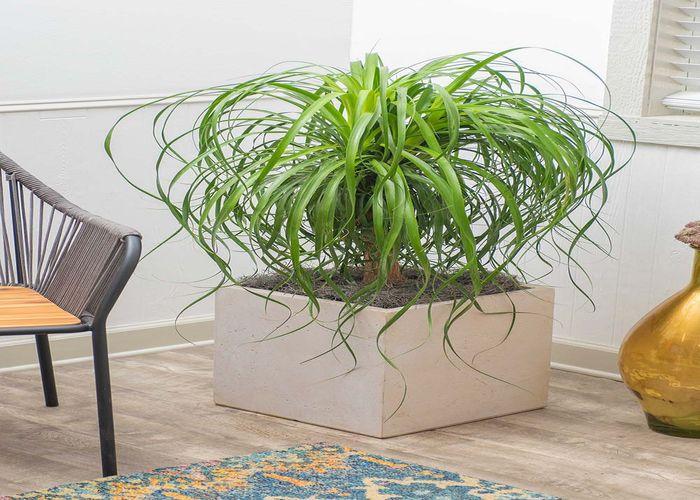
Botanical name: Beaucarnea recurvata
The lush green leaves of this gorgeous palm resemble a ponytail tied up on a kid’s head. The bulbous trunk stores water, which is why it is a suitable indoor plant collection.
This plant is perfect for the lazy gardener or the novice, as the plants require little maintenance and look wonderful. These plants are succulent, which means they can store a lot of water in their roots and trunks. This makes it easy to keep them healthy.
Ponytail Palm Indoor Care Instructions
Light: With partial sunlight for a certain period of the day, they will be perfectly fine. Under drastic weather conditions, you should keep the bulbs in bright light for half of the year and in low or less light for the other half.
Soil: Consider using fast-draining soil like cacti and succulent potting mix.
Water: Since it is a succulent plant species, it does not require daily watering. When the topsoil is not completely dry, you can water it once or twice a week. Because of the way they store water, they can survive with little or no water.
Fertilizer: Give a weekly dose of fertilizer in liquid form in the growing season. You can give a slow-release fertilizer as well, but you should reduce of amount of fertilizer you feed in winter.
42. Begonia
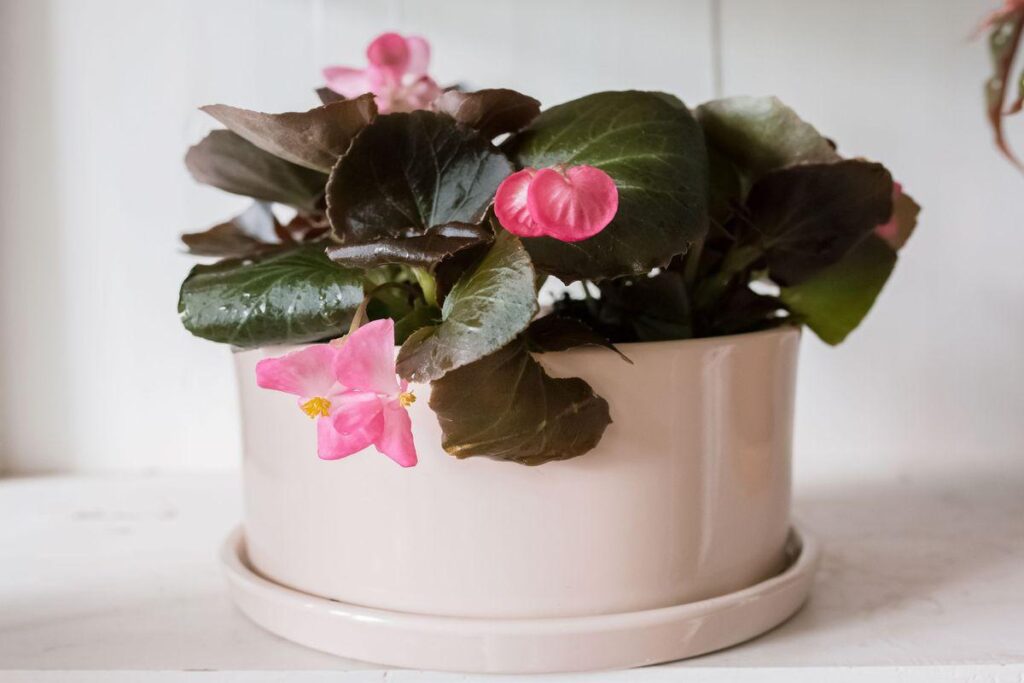
Botanical name: Begonia
They are incredibly easy to grow, look fantastic in your garden or indoors, and are fairly low maintenance. It does not matter if they are small potted or long, as long as the soil is treated properly, they will thrive. In the world, there are more than 1700 varieties of Begonia.
With their beautiful short leaves and colorful flowers, begonias add a touch of charm to your house. This is a great choice if you’re looking to add some flowering varieties to your home.
Begonias Care Instructions
Light: A partially lit space will be ideal for growing them. They do not like direct sunlight. Avoid displaying your indoor plants near hot glass windows. Place them in locations where they will receive partial sunlight.
Soil: A light, fertile, well-drained soil is ideal for growing begonias. Root and stem rot is a very common problem in begonias when exposed to cold, wet soil, so proper drainage is crucial.
Water: Begonias are not fond of too much water, so it is better to have well-drained soil. As soon as they bloom, you can use them to decorate your home.
Fertilizer: Begonias are available in different types, for example, Tuberous begonias, Fibrous begonias, Rhizomatous Begonias, etc. Fertilizer needs for these plants depends on the cultivar. Rhizomatous Begonias would love basic water-soluble fertilizer in spring, while Tuberous begonias are hearty feeders, they prefer 5-1-1 fertilizer twice a month during the growing season.
Conclusion
The above-compiled list of plants is the most popular indoor plant in India. It has been scientifically proven that some common indoor plants in India can relieve stress and anxiety, boost your home’s positivity, and improve your productivity. So, make your house more fresh, relaxed, and lively by bringing these indoor plants today.
So, which indoor plant are you planning to grow? Let us know in the comment section.
Related Posts
- Bonsai for Beginners in India [Update 2024]

- 15 Best Plants for Front Door Entrance India | Auspicious plants for front door

- 10 Study Table Decoration Ideas That Will Make You Love Learning

- Revive Your Bonsai Tree with These Proven Techniques!

- Top 15 Benefits of Bonsai Plants that will Make your Life Awesome

- Top 10 Indoor Plants for Cafes to Enhance Decor & Comfort


